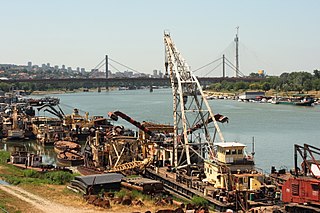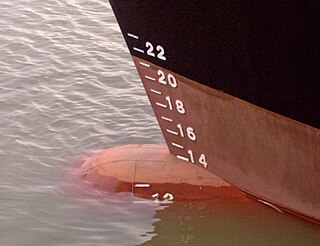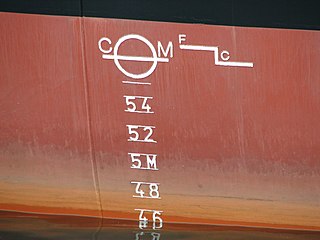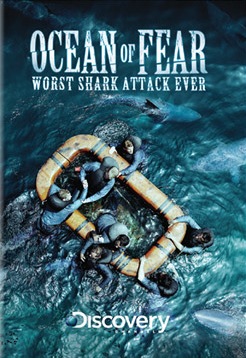Related Research Articles

A hull is the watertight body of a ship, boat, submarine, or flying boat. The hull may open at the top, or it may be fully or partially covered with a deck. Atop the deck may be a deckhouse and other superstructures, such as a funnel, derrick, or mast. The line where the hull meets the water surface is called the waterline.

A ship is a large vessel that travels the world's oceans and other navigable waterways, carrying cargo or passengers, or in support of specialized missions, such as defense, research and fishing. Ships are generally distinguished from boats, based on size, shape, load capacity and purpose. Ships have supported exploration, trade, warfare, migration, colonization, and science. Ship transport is responsible for the largest portion of world commerce.

Maritime transport or more generally waterborne transport, is the transport of people (passengers) or goods (cargo) via waterways. Freight transport by sea has been widely used throughout recorded history. The advent of aviation has diminished the importance of sea travel for passengers, though it is still popular for short trips and pleasure cruises. Transport by water is cheaper than transport by air or ground, but significantly slower for longer distances. Maritime transport accounts for roughly 80% of international trade, according to UNCTAD in 2020.

Transshipment, trans-shipment or transhipment is the shipment of goods or containers to an intermediate destination, then to another destination.

MS Estonia was a cruiseferry built in 1980 for the Finnish shipping company Rederi Ab Sally by Meyer Werft, in Papenburg, West Germany. She was employed on ferry routes between Finland and Sweden by various companies until in the end of January 1993, when she was sold to Nordström & Thulin for use on Estline's Tallinn–Stockholm route. The ship's sinking on 28 September 1994, in the Baltic Sea between Sweden, Finland and Estonia, was one of the worst peacetime maritime disasters of the 20th century, claiming 852 lives.

A riverboat is a watercraft designed for inland navigation on lakes, rivers, and artificial waterways. They are generally equipped and outfitted as work boats in one of the carrying trades, for freight or people transport, including luxury units constructed for entertainment enterprises, such as lake or harbour tour boats. As larger water craft, virtually all riverboats are especially designed and constructed, or alternatively, constructed with special-purpose features that optimize them as riverine or lake service craft, for instance, dredgers, survey boats, fisheries management craft, fireboats and law enforcement patrol craft.

A bulk carrier or bulker is a merchant ship specially designed to transport unpackaged bulk cargo—such as grain, coal, ore, steel coils, and cement—in its cargo holds. Since the first specialized bulk carrier was built in 1852, economic forces have led to increased size and sophistication of these ships. Today's bulk carriers are specially designed to maximize capacity, safety, efficiency, and durability.

Deadweight tonnage or tons deadweight (DWT) is a measure of how much weight a ship can carry. It is the sum of the weights of cargo, fuel, fresh water, ballast water, provisions, passengers, and crew.

The waterline is the line where the hull of a ship meets the surface of the water. Specifically, it is also the name of a special marking, also known as an international load line or Plimsoll line, that indicates the draft of the ship and the legal limit to which a ship may be loaded for specific water types and temperatures in order to safely maintain buoyancy, particularly with regard to the hazard of waves that may arise. Varying water temperatures will affect a ship's draft, because warm water is less dense than cold water, providing less buoyancy. In the same way, fresh water is less dense than salinated or seawater with a similar lessening effect upon buoyancy.

Nikoloz Tskitishvili is a Georgian former professional basketball player. At 7 feet tall, he played as forward-center. Tskitishvili was selected fifth overall by the Denver Nuggets in the 2002 NBA draft. He also played for the senior Georgian national basketball team.

SS Milwaukee was a train ferry that served on Lake Michigan. It was launched in 1902 and sank with all hands off Milwaukee on October 22, 1929. Fifty-two men were lost with the vessel.
The stability conditions of watercraft are the various standard loading configurations to which a ship, boat, or offshore platform may be subjected. They are recognized by classification societies such as Det Norske Veritas, Lloyd's Register and American Bureau of Shipping (ABS). Classification societies follow rules and guidelines laid down by International Convention for the Safety of Life at Sea (SOLAS) conventions, the International Maritime Organization and laws of the country under which the vessel is flagged, such as the Code of Federal Regulations.
The 2007 WNBA draft was the league's annual process for determining which teams receive the rights to negotiate with players entering the league.

The draft or draught of a ship is a determined depth of the vessel below the waterline, measured vertically to its hull's lowest—its propellers, or keel, or other reference point. Draft varies according to the loaded condition of the ship. A deeper draft means the ship will have greater vertical depth below the waterline. Draft is used in under keel clearance calculations, where the draft is calculated with the available dept of water to ensure the ship can navigate safely, without grounding. Navigators can determine their draught by calculation or by visual observation.

USS Monocacy was one of two shallow draft gunboats designed for service on the upper Yangtze River over 900 miles (1,400 km) inland. It was pre-constructed at Mare Island Navy Yard in 1912 and then dismantled and shipped to Shanghai, China. She was laid down by the Shanghai Dock & Engineering Co. 28 April 1913. One year later, or 27 April 1914 she was launched, sponsored by Mrs. Andrew E. Carter, and commissioned 24 June 1914.

Ocean of Fear: Worst Shark Attack Ever is a 2007 made-for-television documentary film that launched the 20th anniversary of the Discovery Channel's Shark Week of 2007. It recounts the sinking of the USS Indianapolis. The show initially aired on July 29, 2007, on the eve of the anniversary of the ship’s sinking in 1945.

The displacement or displacement tonnage of a ship is its weight. As the term indicates, it is measured indirectly, using Archimedes' principle, by first calculating the volume of water displaced by the ship, then converting that value into weight. Traditionally, various measurement rules have been in use, giving various measures in long tons. Today, tonnes are more commonly used.

Net tonnage is a dimensionless index calculated from the total moulded volume of the ship's cargo spaces by using a mathematical formula. Defined in The International Convention on Tonnage Measurement of Ships that was adopted by the International Maritime Organization in 1969, the net tonnage replaced the earlier net register tonnage (NRT) which denoted the volume of the ship's revenue-earning spaces in "register tons", units of volume equal to 100 cubic feet (2.83 m3). Net tonnage is used to calculate the port duties and should not be taken as less than 30 per cent of the ship's gross tonnage.

The SS Pewabic was a package freighter that served ports on the Upper Great Lakes. She was launched in October 1863, fitted out in the spring of 1864, and was in active service until she sank off Thunder Bay Island in Lake Huron on August 9, 1865, due to collision with her sister vessel. There was significant loss of life, with a number variously estimated at 100 or 125 passengers and crew of the stricken vessel going down with the ship. If the higher number is accepted, the loss of life made this disaster, in terms of loss of life from the sinking of a single vessel, the seventh-worst tragedy in the history of the Great Lakes, and the worst ever on Lake Huron. The sunken hull of the package freighter is a feature of the present-day Thunder Bay National Marine Sanctuary.
The Montego 20 is an American trailerable sailboat that was designed by Johannes "Jopie" Helsen as a pocket cruiser and first built in 1976.
References
- "Summer Draft". hansa-online.de (in German). Archived from the original on 2007-09-27. Retrieved 2007-06-11.